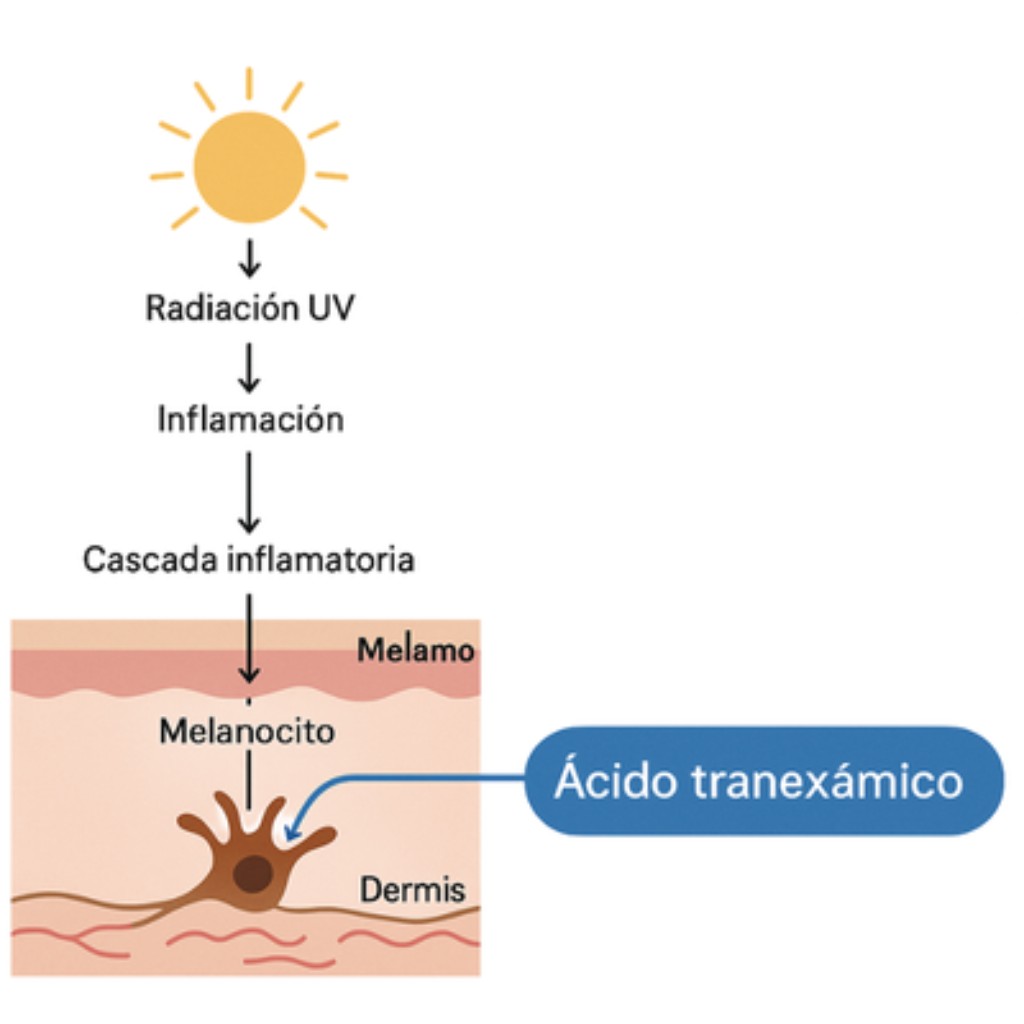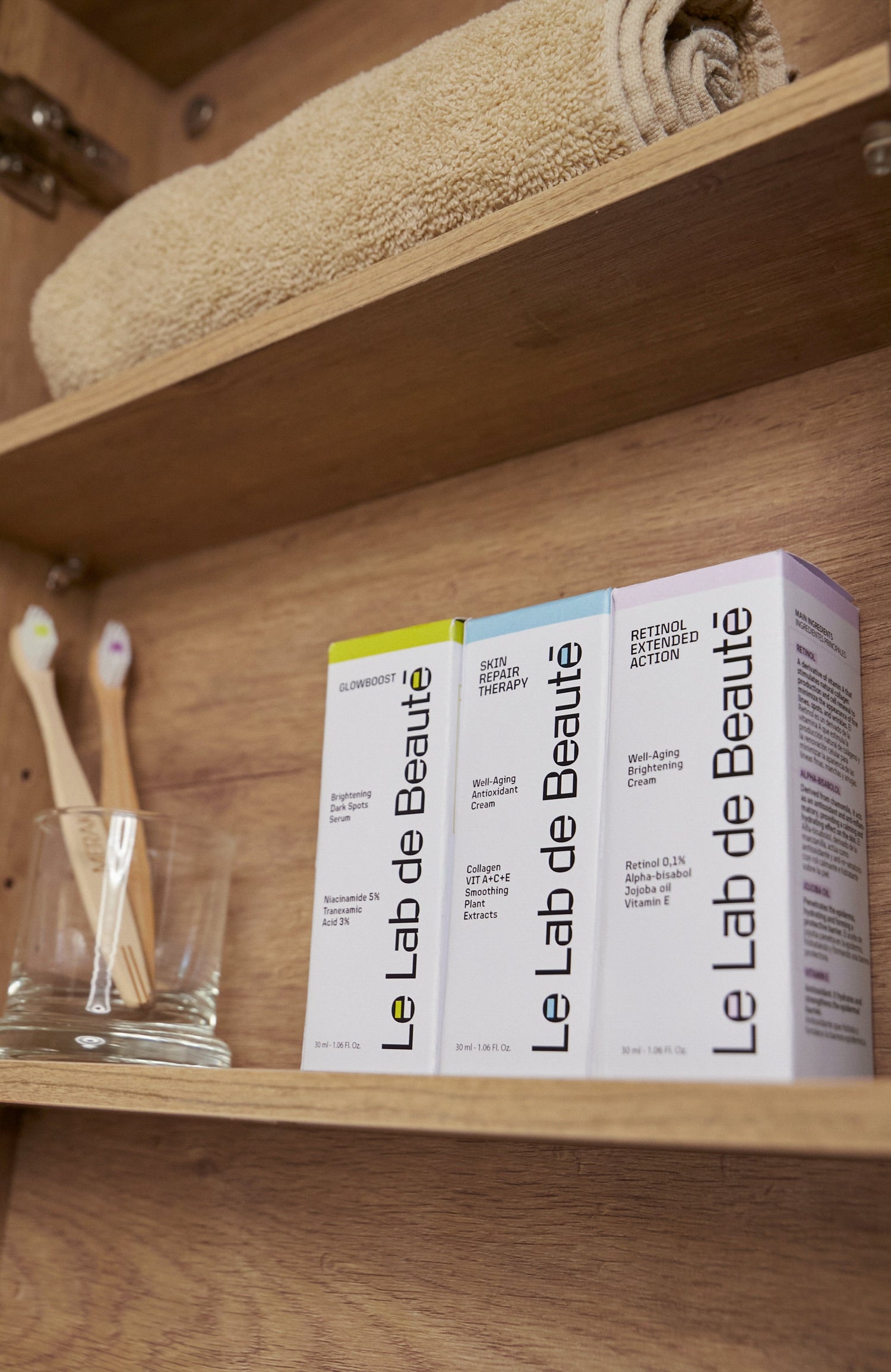
Tranexamic Acid: the active ingredient that revolutionizes the treatment of dark spots
Share
The search for even, luminous, and blemish-free skin is one of the main reasons for consultations in aesthetic medicine. While there are various active ingredients with depigmenting effects, one that has gained increasing prominence in recent years due to its effectiveness and tolerability is tranexamic acid.
In Le Lab de Beauté , as a pharmaceutical laboratory specializing in professional cosmetics and aesthetic medicine, develops solutions that combine science, innovation, and pharmaceutical quality. In this article, we explore the potential of tranexamic acid as a depigmenting agent, its mechanism of action, and its most effective uses.
What is tranexamic acid?
Tranexamic acid is a synthetic derivative of the amino acid lysine. It was originally used in conventional medicine as an antifibrinolytic, that is, to prevent excessive bleeding during surgery or hemorrhagic processes.
However, more recent dermatological research has shown that this active ingredient has a potent depigmenting action, making it a key ingredient for treating various forms of hyperpigmentation, such as melasma, sun spots, and post-inflammatory hyperpigmentation.
How does it act as a depigmenting agent?
Unlike other active ingredients that act directly on melanin synthesis, tranexamic acid acts at an earlier stage of the pigmentation process: inflammation.
Its main mechanism is based on:
- Inhibit plasminogen activation, which reduces the release of inflammatory mediators (such as prostaglandins and arachidonic acid) that stimulate melanogenesis.
- Reduce excessive melanocyte activity without altering their physiological functioning.
- Prevent the appearance of new spots induced by UV radiation, inflammation or hormonal changes.
This "anti-inflammatory" approach makes it a safe active ingredient, especially suitable for sensitive skin, high phototypes, and cases where other depigmenting agents can cause irritation.

Most frequent indications
- Melasma: both epidermal and dermal.
- Post-inflammatory spots: commonly derived from acne or cosmetic procedures.
- Chronic solar hyperpigmentation.
- Reactive or sensitized skin, where a non-irritating depigmenting alternative is required.
Synergistic combinations
Tranexamic acid can enhance its effect when combined with other complementary dermocosmetic active ingredients:
- Niacinamide: antioxidant, inhibits melanin transfer and strengthens barrier function.
- Vitamin C: antioxidant, brightens and improves tone.
- Kojic acid: inhibits tyrosinase, a key enzyme in melanin synthesis.
- Retinol: promotes cell renewal, although precautions are required for sensitive skin.
These combinations allow hyperpigmentation to be addressed through different mechanisms, achieving more visible and sustained results.
Professional techniques and ways of use
Tranexamic acid can be used in various formats, both in the doctor's office and at home. Below, we review the main application techniques and their clinical impact:
- Chemical peels with tranexamic acid : combined with other depigmenting or exfoliating acids for a synergistic effect. At Le Lab de Beauté, we developed the Depigmenting Peel with tranexamic acid, indicated for stubborn dark spots such as melasma and solar lentigines.
- Facial mesotherapy : intradermal microinjections of pure or combined tranexamic acid for high precision and clinical results.
- Microneedling : facilitates topical penetration of the active ingredient and stimulates dermal regeneration.
- Electroporation : transdermal introduction using electrical impulses, a non-invasive technique safe for sensitive skin.
- Iontophoresis : use of galvanic current for intracellular penetration in advanced protocols.
- Topical application (cosmeceutical serums) : daily use with products formulated for high tolerance and efficacy.
💡 At Le Lab de Beauté, we're about to launch a new depigmenting serum with tranexamic acid, designed for medical treatments or intensive home routines, effective and non-irritating.
Complementary care
- Broad spectrum SPF 45+ sunscreen, reapplied every 2 hours.
- Gentle, irritant-free cleansing routine.
- Be consistent and patient: stains take time to resolve safely.
Conclusion
Tranexamic acid has established itself as one of the most promising and safe active ingredients in the treatment of dark spots, thanks to its ability to modulate pigmentation from its inflammatory origin. Whether used professionally or at home, it offers visible and sustainable results without compromising skin health.
In At Le Lab de Beauté , we develop products with this active ingredient for both medical use and high-quality cosmeceutical care, with technical support, proven efficacy, and formulations designed with pharmaceutical criteria.
Would you like to learn more about our tranexamic acid products or seek advice on incorporating them into professional protocols?
Contact us or write to our technical team for more information.

